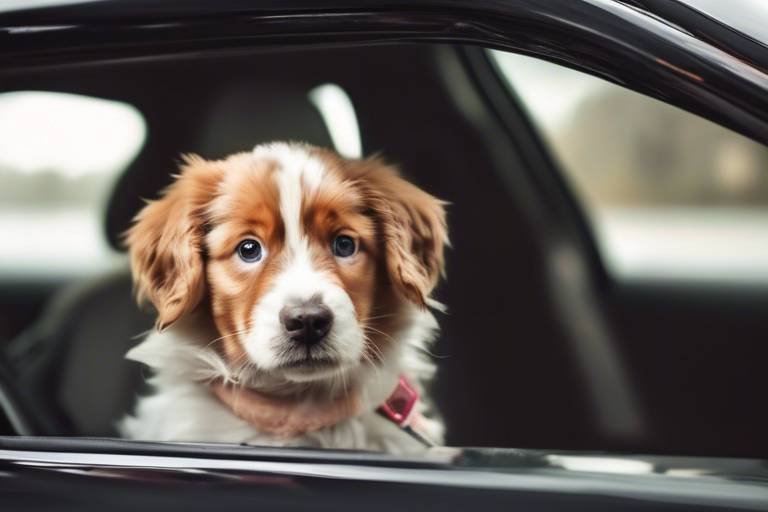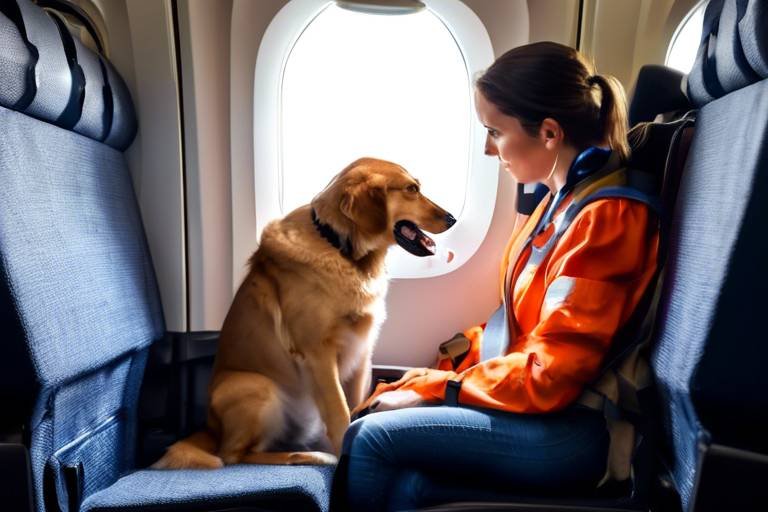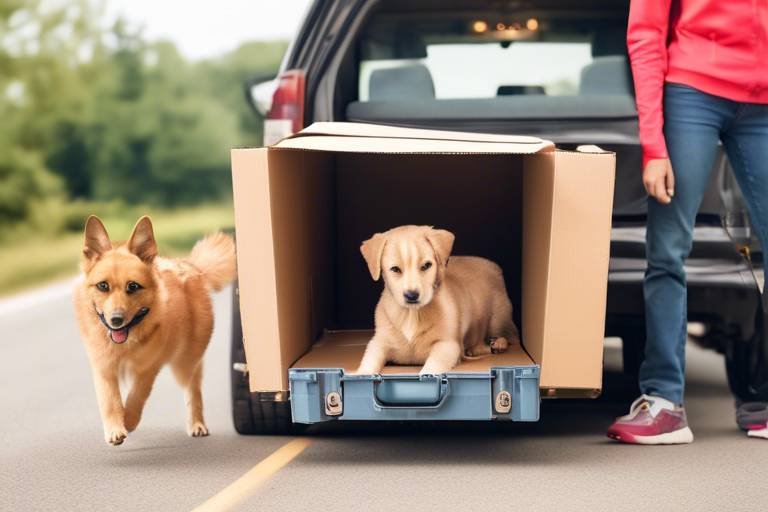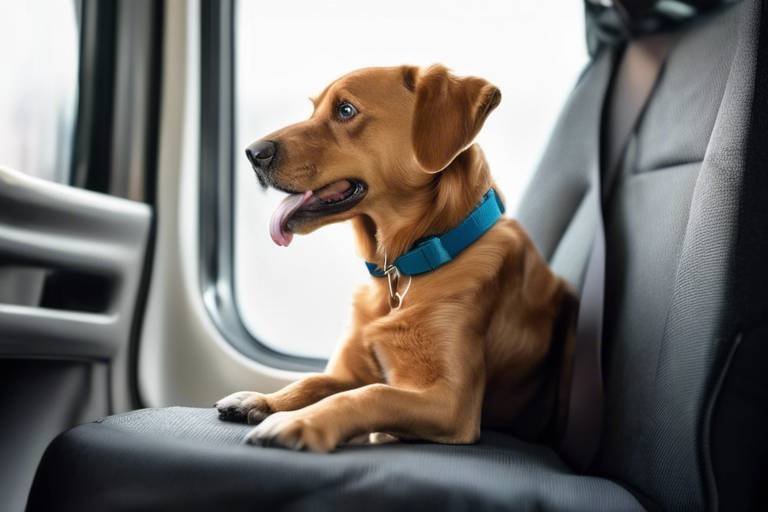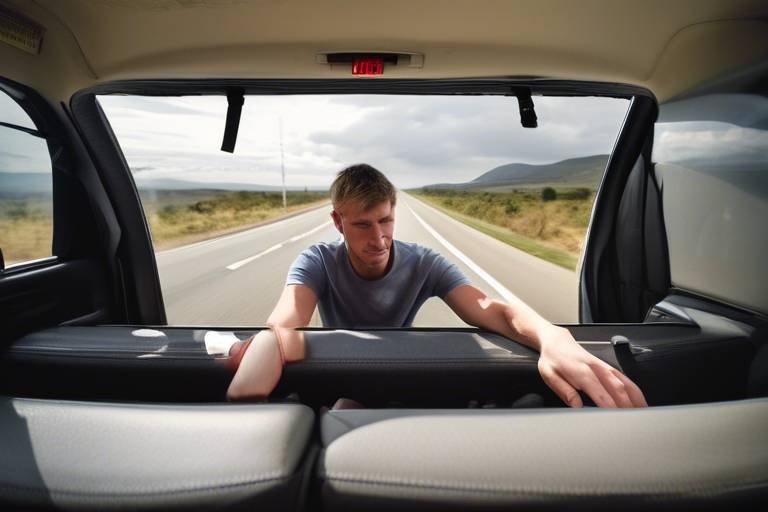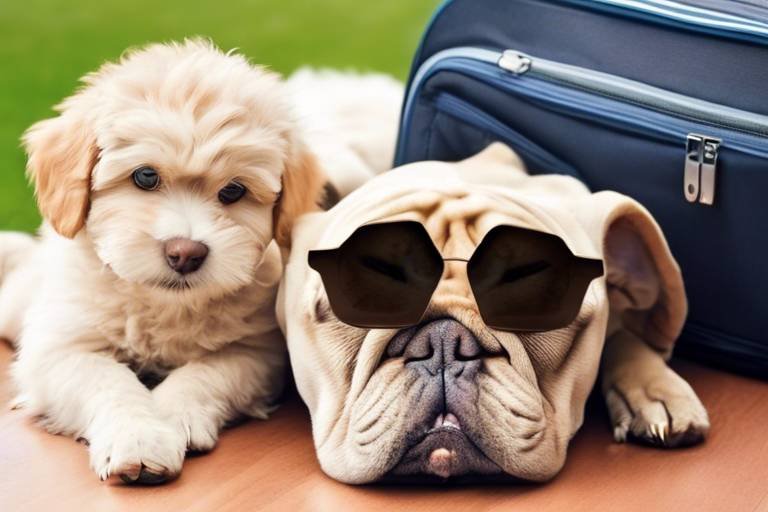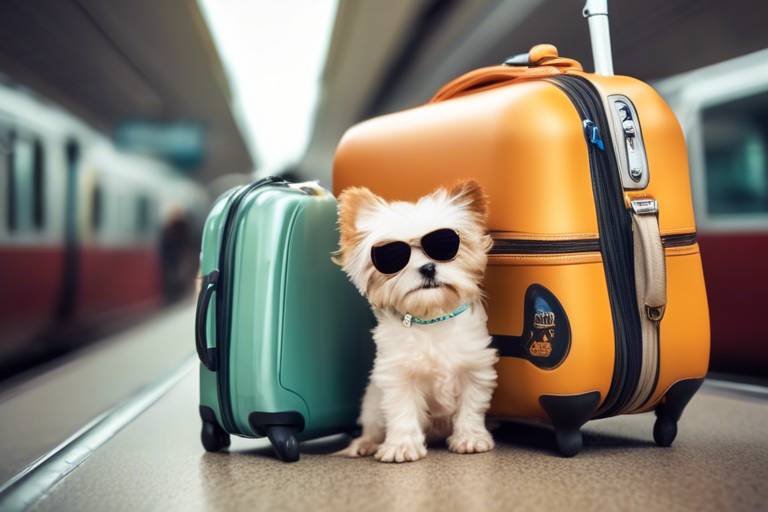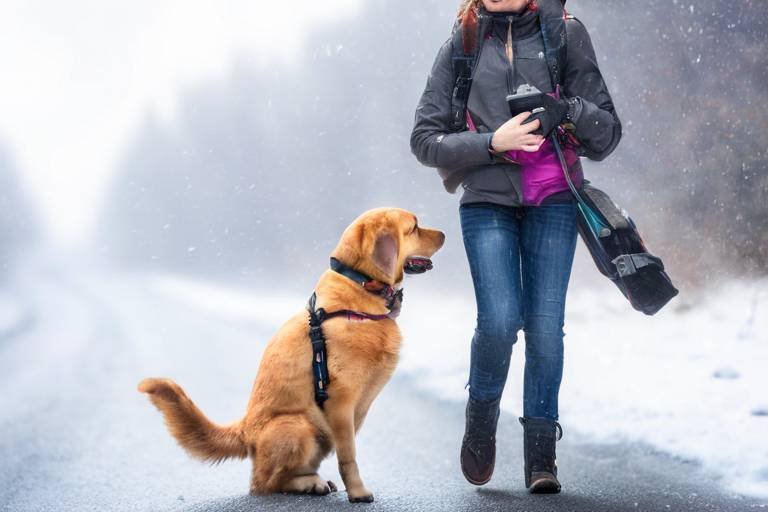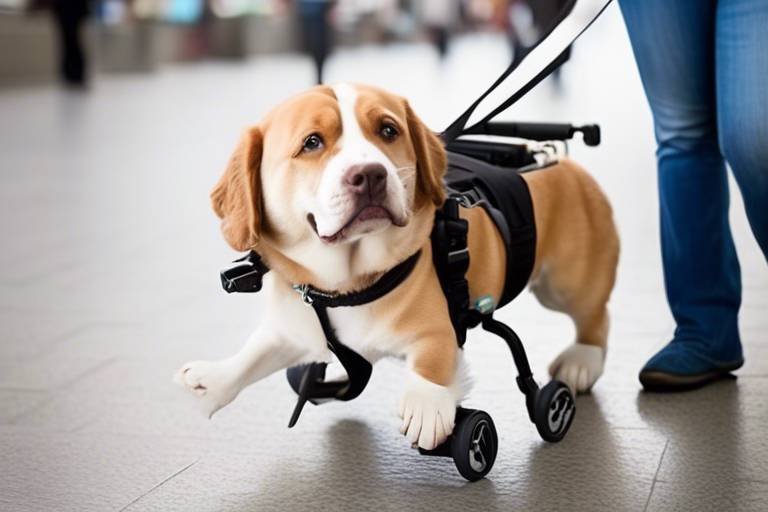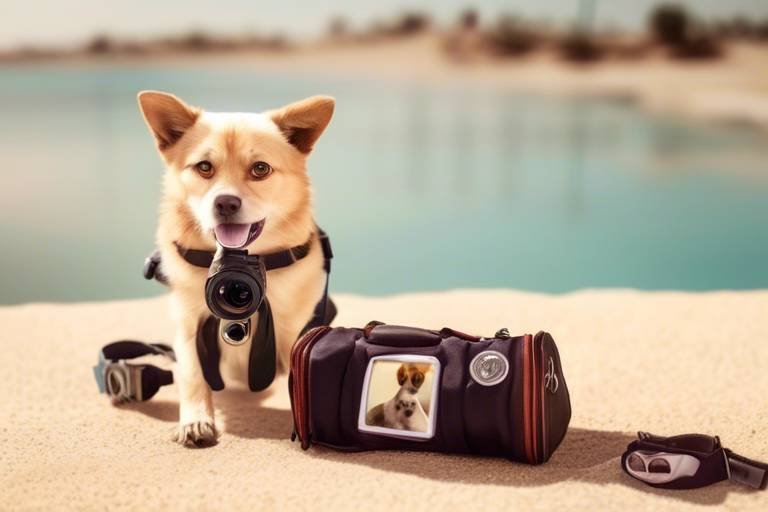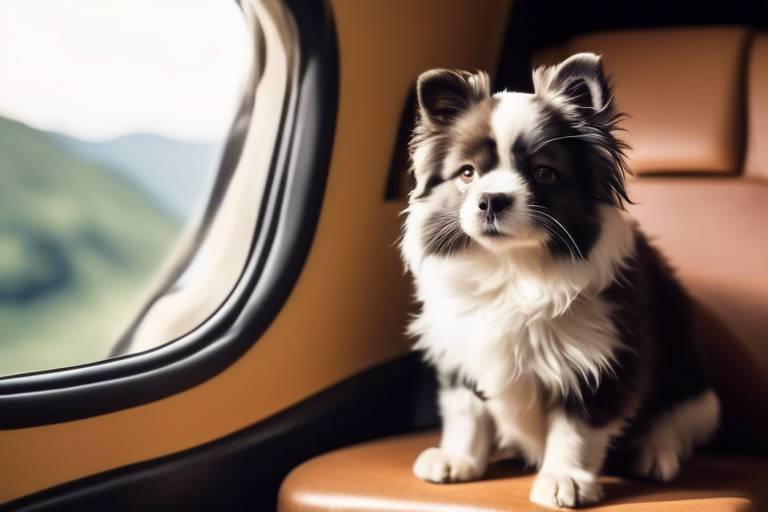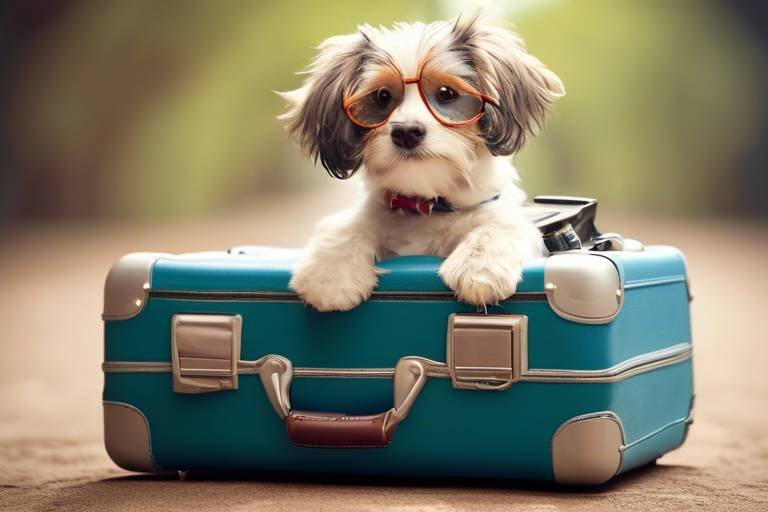The Best Practices for Car Safety with Pets
Traveling with your furry friends can be one of the most rewarding experiences, but it comes with its own set of challenges. As a responsible pet owner, ensuring the safety of your pets during car rides is not just a good practice; it's essential. Imagine hitting the open road with your dog’s ears flapping in the wind, or your cat curiously peeking out the window. Sounds delightful, right? However, without proper precautions, this joy can quickly turn into a nightmare. In this article, we will explore essential tips and guidelines that will make your journeys not only safe but also comfortable for both you and your pets.
Before we dive into the best practices, it’s crucial to understand the risks involved in traveling with pets. Did you know that unrestrained pets can become dangerous projectiles during sudden stops or accidents? According to research, an unrestrained dog can weigh up to 60 times more in a crash! This alarming statistic emphasizes the need for safety measures. Additionally, pets can easily become distracted drivers, leading to potential accidents. Ensuring that your pet is secure in the vehicle not only protects them but also keeps you and other road users safe. Understanding these risks is the first step in making informed decisions about pet travel safety.
Now that we know the risks, let’s talk about how to mitigate them. Selecting an appropriate restraint system is vital for pet safety. Just like we buckle up for our own safety, our pets need to be secured as well. There are various options available, including harnesses, crates, and barriers. Each of these has its own set of advantages and disadvantages based on your pet's size, temperament, and travel habits. Investing in the right restraint can prevent injuries during sudden stops or accidents, making it a worthwhile consideration.
When it comes to pet restraints, there’s no one-size-fits-all solution. Here’s a quick comparison of the most popular types:
| Type | Advantages | Disadvantages |
|---|---|---|
| Seatbelt Harnesses | Allows some movement, easy to use | Not all harnesses are crash-tested |
| Travel Crates | Provides a secure environment | Can be bulky, may require training |
| Pet Barriers | Reduces distractions for drivers | May not prevent pets from jumping over |
Seatbelt harnesses are a fantastic option for pet owners who want to keep their pets secure while still allowing them some freedom to move. These harnesses attach to the car’s seatbelt system and come in various sizes to accommodate different breeds. When choosing a seatbelt harness, look for features such as durability, comfort, and if it has been crash-tested. A well-fitted harness can keep your pet safe and snug during the ride, preventing them from jumping around or distracting you.
Travel crates are another excellent choice, especially for smaller pets or those who feel more secure in a confined space. A properly sized crate can provide a safe haven for your pet during the journey. When selecting a crate, ensure it’s well-ventilated, sturdy, and spacious enough for your pet to stand, turn around, and lie down comfortably. Crate training your pet before the trip can also make them feel more at ease, turning the crate into a familiar and safe space.
For larger pets, pet barriers can be a practical solution. These barriers are designed to keep your pet in the back seat, minimizing distractions while you drive. They come in various styles, such as adjustable mesh or solid panels, and can be easily installed and removed. While barriers are effective, it’s essential to ensure they are securely fitted to prevent any escape attempts from your adventurous furry friend.
Preparation is key to a smooth journey with pets. Before you hit the road, take some time to plan ahead. Make sure your pet is comfortable with the travel arrangements, and always consider their needs. This includes packing essential supplies that can enhance their comfort and safety.
When traveling with pets, packing the right supplies can make a world of difference. Here’s a checklist of must-have items:
- Water and a portable bowl
- Pet food and treats
- First aid kit for pets
- Leash and collar with ID tags
- Comfort items, like a favorite blanket or toy
Long trips can be tiring for pets, so it’s important to plan for regular breaks. Aim to stop every 2-3 hours to allow your pet to stretch their legs, hydrate, and relieve themselves. During these breaks, take a moment to check on your pet’s comfort and adjust their restraints if necessary. These small pauses can make a huge difference in keeping your pet happy and healthy during your travels.
1. Is it safe to let my dog stick their head out the window?
No, it’s not safe. While it may look cute, it can lead to serious injuries from flying debris or sudden stops.
2. Can I use a regular harness for car travel?
Not all harnesses are designed for car safety. Look for a harness specifically made for vehicle use that has been crash-tested.
3. How can I help my pet feel comfortable in a crate?
Start crate training at home before your trip. Make the crate a positive space with treats, toys, and familiar bedding.
4. What should I do if my pet gets anxious during travel?
Consider using calming aids or consult your veterinarian for advice on how to manage travel anxiety.

Understanding the Risks
Traveling with your furry friend can be one of the most rewarding experiences, but it also comes with its own set of challenges and risks. Did you know that an unrestrained pet can become a projectile during a sudden stop or an accident? This can lead not only to serious injuries for your pet but also for you and your passengers. It's essential to recognize these potential dangers to make informed decisions that prioritize the safety of everyone in the vehicle.
Common hazards include distractions while driving, which can arise when a pet moves freely around the car. Imagine trying to navigate a busy road while your pup is excitedly jumping from the backseat to your lap! This can divert your attention from the road, increasing the likelihood of accidents. Additionally, pets can suffer from anxiety during car rides, which can lead to erratic behavior. This anxiety can be exacerbated by loud noises or sudden movements, making it crucial to create a calm and secure environment.
Moreover, the temperature inside a vehicle can rise dramatically, even on seemingly mild days. Leaving your pet in a hot car for just a few minutes can lead to heatstroke, which is often fatal. It's vital to keep an eye on the weather and plan accordingly. Here are some risks to consider:
- Injury from sudden stops: Unrestrained pets can be thrown around the vehicle.
- Distraction while driving: Pets moving around can divert your attention.
- Heatstroke: Cars can heat up quickly, endangering your pet's life.
- Anxiety and stress: Pets may feel anxious in a moving vehicle, leading to unpredictable behavior.
By understanding these risks, you can take proactive steps to mitigate them. Implementing safety measures, such as using proper restraints and preparing adequately for your trip, can make a world of difference. Remember, the goal is to ensure a smooth and enjoyable journey for both you and your beloved pet. Always prioritize their safety and well-being, and you'll create memories that you both will cherish for a lifetime!
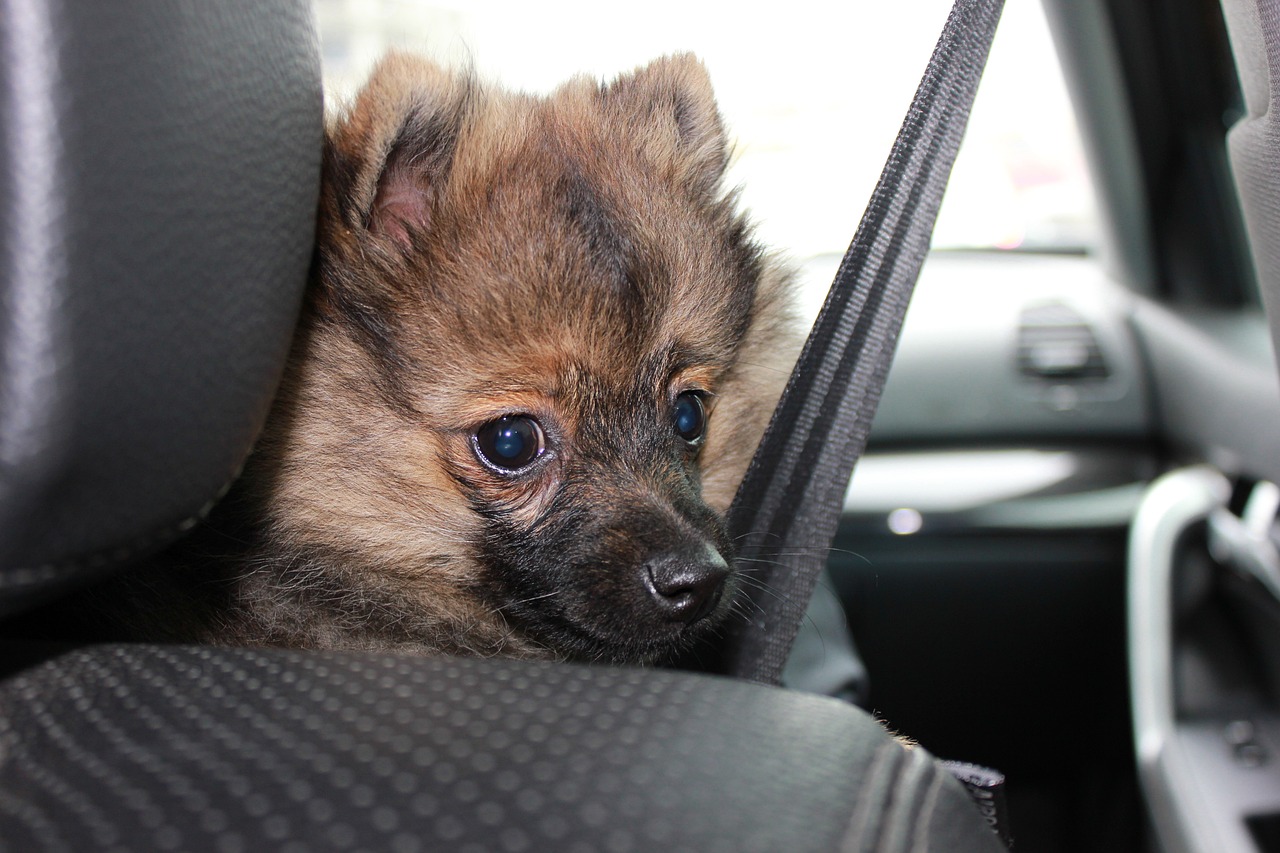
Choosing the Right Restraint
When it comes to keeping our furry friends safe during car rides, choosing the right restraint is absolutely crucial. Just like we buckle up for safety, our pets deserve the same level of protection. Imagine driving down the highway at 60 mph, and suddenly slamming on the brakes—without a proper restraint, your pet could be thrown around the car, potentially leading to serious injuries. That's why investing time in selecting the right restraint system is not just a good idea; it's a necessity.
There are several options available, each designed to cater to different needs and preferences. The most popular choices include seatbelt harnesses, travel crates, and pet barriers. Each of these options has its own set of advantages and disadvantages, depending on your pet's size, temperament, and how you plan to travel. For instance, while a seatbelt harness allows your pet some movement, a travel crate can provide a more secure environment. Understanding these differences can help you make an informed decision that prioritizes your pet's safety.
Let’s break down the different types of restraints and see how they stack up against each other:
| Type of Restraint | Advantages | Disadvantages |
|---|---|---|
| Seatbelt Harnesses |
|
|
| Travel Crates |
|
|
| Pet Barriers |
|
|
As you can see, each restraint type has its pros and cons. If you have a larger dog, a travel crate might be the best option, while a smaller dog may thrive in a seatbelt harness. It's essential to consider your pet's unique needs and preferences when making your choice. The goal is to create a safe environment where both you and your pet can enjoy the journey without unnecessary stress.
Moreover, don’t forget to introduce your pet to the restraint system before your trip. This acclimatization process can make a world of difference in how comfortable they feel during the ride. Whether it’s a harness or a crate, allowing your pet to explore and get used to it at home can help reduce anxiety and ensure a smoother travel experience.
In conclusion, choosing the right restraint is a vital step in ensuring the safety of your pet while traveling. By understanding the different options available and considering your pet's specific needs, you can make a choice that not only keeps them safe but also makes the journey more enjoyable for everyone involved.
Types of Pet Restraints
When it comes to traveling with our furry friends, choosing the right restraint is crucial for ensuring their safety and comfort. Just like we buckle up to protect ourselves, our pets deserve the same level of protection during car rides. There are several types of pet restraints available, each designed with different needs in mind. Understanding these options can help you make an informed choice that keeps your pet secure while allowing for a bit of freedom to move around.
One of the most popular options is the seatbelt harness. These harnesses attach directly to your car's seatbelt system, providing a secure way to keep your pet restrained without completely restricting their movement. Imagine your dog feeling the wind on their face while safely secured in the back seat—sounds delightful, right? However, it’s important to choose a harness that fits well and is made from durable materials to withstand sudden stops or accidents.
Next up, we have travel crates. These sturdy enclosures offer a cozy and safe environment for pets during car trips. Think of it as their own little sanctuary on wheels! Crates can be particularly beneficial for anxious pets who might feel more secure in a confined space. When selecting a crate, ensure it’s the right size for your pet, allowing them to stand, turn around, and lie down comfortably. Crate training your pet before the trip can also help them adjust to this new travel arrangement.
Then there are pet barriers, which serve as a physical boundary between the front and back seats of your vehicle. These barriers can be especially useful for larger dogs that have a tendency to roam around, distracting the driver. By preventing pets from jumping into the front seat, barriers help maintain focus on the road, reducing the risk of accidents. However, it’s important to ensure that the barrier is properly installed and sturdy enough to withstand any enthusiastic movements from your pet.
To give you a clearer picture, here’s a quick comparison of the three types of restraints:
| Type of Restraint | Advantages | Disadvantages |
|---|---|---|
| Seatbelt Harness |
|
|
| Travel Crates |
|
|
| Pet Barriers |
|
|
In conclusion, choosing the right type of restraint for your pet is not just a matter of preference; it’s about ensuring their safety and comfort on the road. Whether you opt for a seatbelt harness, a travel crate, or a pet barrier, always remember to consider your pet’s size, temperament, and the specifics of your journey. By making an informed choice, you can create a secure travel environment that allows both you and your pet to enjoy the ride!
1. Can I use a regular dog leash as a restraint in the car?
Using a regular dog leash is not recommended as a car restraint. It does not provide the necessary security and can lead to injury during sudden stops.
2. How do I know if a seatbelt harness fits my pet properly?
A seatbelt harness should fit snugly but not too tight. You should be able to fit two fingers between the harness and your pet's body. Always check the manufacturer's sizing guide.
3. Are travel crates safe for all types of pets?
Travel crates are generally safe for most pets, but ensure that the crate is appropriately sized and well-ventilated. Some pets may require additional training to feel comfortable in a crate.
4. How often should I take breaks during long trips with my pet?
It’s best to take breaks every 2-3 hours to allow your pet to stretch, relieve themselves, and hydrate. This helps keep them comfortable and reduces anxiety during long travels.
Seatbelt Harnesses
When it comes to ensuring your furry friend’s safety during car rides, are a game changer. These innovative devices are designed to keep your pet securely restrained while still allowing them some freedom to move around within the confines of the vehicle. Imagine trying to drive with your dog jumping around the car; it’s not only distracting but can also be dangerous! A seatbelt harness keeps your pet in place, minimizing the risk of injury during sudden stops or sharp turns.
One of the standout features of seatbelt harnesses is their ability to connect directly to your car's seatbelt system. This means that you don’t have to worry about complicated setups or additional equipment. Simply buckle your pet in, and you’re ready to hit the road! But not all seatbelt harnesses are created equal. When selecting one, it’s essential to consider factors such as size, material, and adjustability. A harness that fits snugly but comfortably is crucial; it should not be too tight to cause discomfort, yet secure enough to prevent your pet from slipping out.
Here are a few important benefits of using seatbelt harnesses:
- Enhanced Safety: In the event of an accident, a harness can significantly reduce the risk of injury by keeping your pet secured in their seat.
- Comfortable Travel: Many harnesses are padded and designed to distribute pressure evenly, ensuring your pet remains comfortable throughout the journey.
- Easy to Use: Most seatbelt harnesses can be easily clipped on and off, making them convenient for both pets and owners.
When choosing a seatbelt harness, look for one that has been crash-tested and is made from durable materials. This ensures that it can withstand the forces of a collision, providing the utmost protection for your beloved pet. Additionally, consider your pet's size and weight. A harness that is too large may not provide adequate restraint, while one that is too small can cause discomfort or restrict movement.
In conclusion, incorporating a seatbelt harness into your travel routine is not just a smart choice; it’s a responsible one. By prioritizing your pet's safety, you can enjoy peace of mind while on the road, allowing you to focus on what really matters: making wonderful memories with your furry companion!
Travel Crates
Travel crates are an essential tool for ensuring your pet’s safety during car rides. They provide a secure and familiar environment, which can help reduce anxiety for pets who may feel uneasy about traveling. When selecting a travel crate, it’s crucial to consider the size and temperament of your pet. A crate that is too small can be uncomfortable, while one that is too large may not provide the same sense of security. Ideally, your pet should be able to stand, turn around, and lie down comfortably within the crate.
When it comes to crate training, patience is key. Start by introducing your pet to the crate at home, allowing them to explore it freely. You can make the crate more inviting by placing their favorite blanket or toy inside. Gradually, you can begin to close the door for short periods, rewarding them with treats to create a positive association. This process can help your pet feel more at ease during car trips, as they will recognize the crate as a safe space.
There are various types of travel crates available on the market, each designed for different needs. For instance, soft-sided crates are lightweight and portable, making them great for small pets or short trips. However, for larger dogs or longer journeys, hard-sided crates offer more durability and protection. Here’s a quick comparison:
| Type of Crate | Best For | Pros | Cons |
|---|---|---|---|
| Soft-Sided | Small dogs, short trips | Lightweight, easy to store | Less durable, not suitable for chewers |
| Hard-Sided | Large dogs, long trips | Sturdy, provides better protection | Heavier, less portable |
Regardless of the type you choose, ensure that the crate is properly secured in the vehicle to prevent it from moving during sudden stops or turns. Many crates come with built-in tie-down straps or can be secured using the vehicle’s seatbelt system. This added layer of safety is crucial, as it prevents the crate from becoming a projectile in the event of an accident.
In addition to safety, comfort is paramount. Make sure to line the crate with a soft blanket or pet bed to provide a cozy spot for your furry friend. During long trips, consider adding some chew toys or interactive puzzles to keep them entertained and calm. Remember, a well-prepared pet is a happy pet, and investing time in crate training can make all the difference in ensuring a smooth journey.
Pet Barriers
When it comes to keeping your furry friends safe during car rides, are an excellent solution that many pet owners overlook. These barriers serve as a physical divider between the front and back seats, ensuring that your pet remains in the back where they belong. Imagine driving down the highway, and your dog suddenly decides to leap into your lap—yikes! Not only is that a distraction, but it can also lead to dangerous situations. By installing a pet barrier, you can significantly reduce the risk of such incidents, allowing you to focus on the road ahead.
There are various types of pet barriers available, each designed with different materials and mechanisms. Some are adjustable, while others are fixed, and they come in a range of styles to fit different vehicle models. For example, a mesh barrier allows visibility while still keeping your pet contained, whereas a solid barrier offers a more secure option that prevents any potential escape attempts. It's essential to choose a barrier that not only fits your vehicle but also suits your pet's behavior and size. A larger dog may require a sturdier barrier compared to a smaller breed.
One of the key advantages of using pet barriers is that they help reduce distractions for the driver. When pets are free to roam, they can easily become a source of chaos, whether it's barking at passing cars or trying to climb into the front seat. A barrier minimizes these distractions, allowing for a safer driving experience. Additionally, some barriers are designed to be easily removable, making them convenient for owners who may need to switch between transporting pets and passengers.
To help you make an informed decision, here’s a quick comparison table of the different types of pet barriers:
| Type of Barrier | Material | Adjustability | Pros | Cons |
|---|---|---|---|---|
| Mesh Barrier | Fabric | Adjustable | Lightweight, allows visibility | Less sturdy for larger pets |
| Solid Barrier | Plastic/Metal | Fixed | Very secure, durable | Limited visibility |
| Pet Gate | Wood/Metal | Adjustable | Versatile, can be used in various locations | Can be cumbersome to install |
In conclusion, pet barriers are a fantastic investment for any pet owner who frequently travels with their pets. They not only enhance safety but also contribute to a more enjoyable driving experience. By keeping your pet securely in the back seat, you can focus on the road without worrying about your furry friend causing distractions. So, whether you're planning a cross-country road trip or just a quick drive to the vet, consider installing a pet barrier for peace of mind.
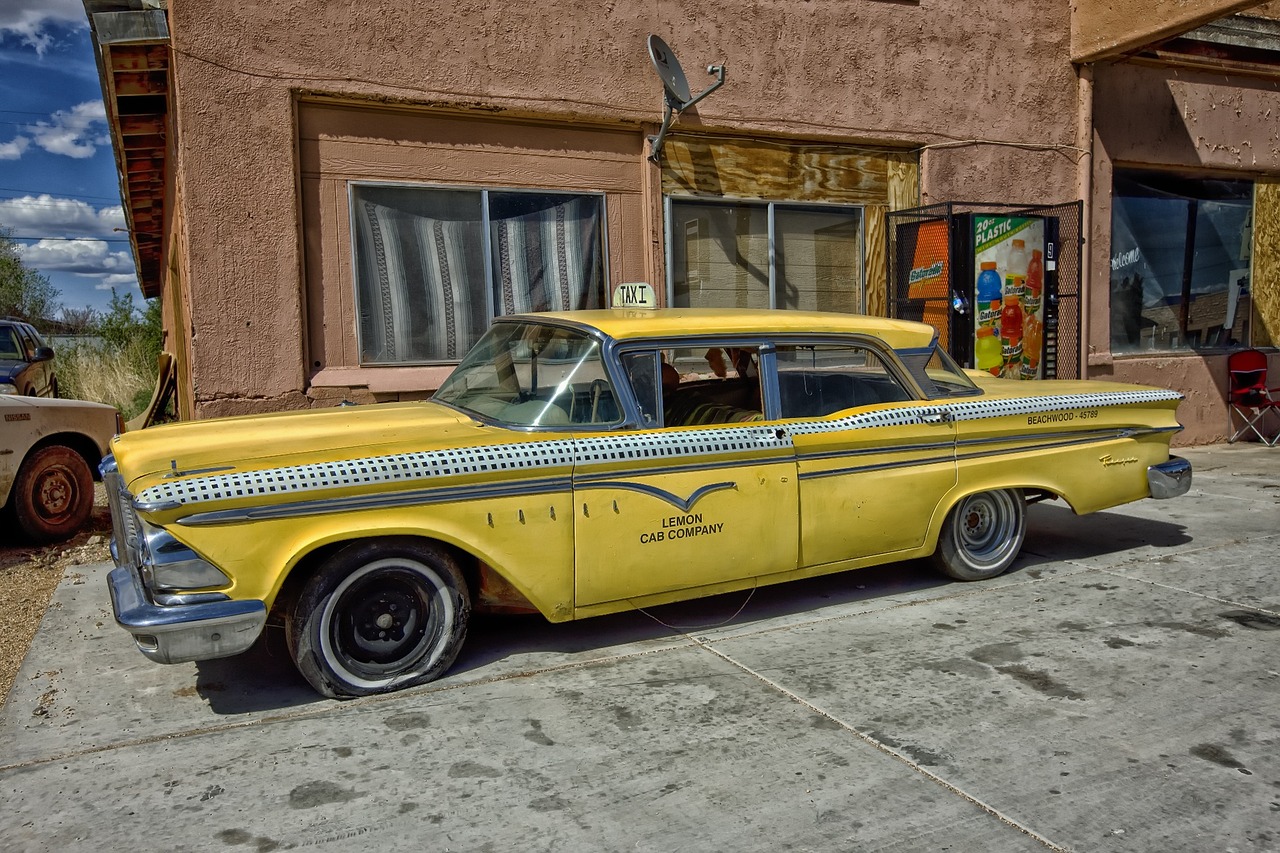
Preparing for the Trip
Preparation is the cornerstone of a successful journey with your furry friends. Imagine embarking on a long road trip only to realize you’ve forgotten your pet’s favorite toy or, worse, their food! This kind of oversight can lead to a stressful experience for both you and your pet. To avoid such pitfalls, it’s essential to plan ahead. Start by creating a comprehensive checklist of everything your pet might need during the trip. This will not only help you stay organized but also ensure that your pet is comfortable and secure throughout the journey.
One of the first steps in preparing for your trip is to pack essential supplies. Think about what your pet will need on the road. Here are some must-have items:
- Water and Food: Always carry enough food and water for your pet, plus a little extra in case of delays.
- First Aid Kit: A basic first aid kit tailored for pets can be a lifesaver in emergencies.
- Leash and Collar: Ensure you have a sturdy leash and collar, especially when making stops.
- Comfort Items: Bring along your pet's favorite blanket or toy to provide a sense of familiarity and comfort.
Additionally, it’s wise to consider your pet’s health needs before you hit the road. Consult with your veterinarian to ensure that your pet is fit for travel and up-to-date on vaccinations. If your pet requires any medications, make sure to pack those as well, along with clear instructions on how and when to administer them.
Another critical aspect of preparation is planning for breaks. Long car rides can be taxing for pets, just as they are for humans. It’s important to schedule frequent stops to allow your pet to stretch their legs, relieve themselves, and hydrate. A good rule of thumb is to take a break every two to three hours. During these stops, let your pet explore a bit, but always keep them on a leash to prevent any unexpected escapes. This is also a great time to check in on their comfort level and adjust their restraints if necessary.
Lastly, familiarize your pet with the car before the trip. If possible, take them on shorter drives leading up to your long journey. This will help them acclimate to the vehicle and reduce anxiety when it’s time for the big trip. Remember, a calm pet makes for a calm journey!
Q: How often should I stop during a long trip with my pet?
A: It’s recommended to stop every 2-3 hours to allow your pet to stretch, relieve themselves, and hydrate.
Q: What should I do if my pet gets anxious during car rides?
A: Consider using calming products like anxiety wraps or consult your veterinarian for advice on medications that can help.
Q: Can I let my pet roam freely in the car?
A: No, it’s unsafe to let your pet roam freely. Always use a proper restraint system to prevent distractions and potential injuries.
Q: What should I include in a pet first aid kit?
A: A basic pet first aid kit should include bandages, antiseptic wipes, tweezers, and any necessary medications.
Pack Essential Supplies
When embarking on a road trip with your furry companions, packing the right supplies is paramount to ensure their comfort and safety. Just like you wouldn’t set out on a journey without your essentials, your pet deserves the same level of preparation. Imagine hitting the road without snacks or water—your pet would feel the same discomfort! So, let’s dive into the must-have items that should be on your packing list.
First and foremost, hydration is key. Always pack enough water for your pet, especially during long trips. It’s advisable to bring a portable water bowl to make hydration easy and mess-free. You wouldn't want your pet to go thirsty, right? A good rule of thumb is to have at least one quart of water for every 10 pounds of your pet’s weight per day. Here’s a quick reference table:
| Pet Weight (lbs) | Water Needed (quarts/day) |
|---|---|
| 10 | 1 |
| 20 | 2 |
| 30 | 3 |
| 40 | 4 |
Next up is food. It’s essential to bring enough of your pet’s regular food to avoid any stomach upsets caused by sudden dietary changes. Pack it in a sturdy, sealed container to keep it fresh and protected from spills. If your trip is going to be long, consider portioning out their meals in advance, so you can easily manage feeding times without the hassle.
Don’t forget to include a first aid kit tailored for pets. This kit should contain basic supplies such as antiseptic wipes, bandages, and any medications your pet may need. Just imagine the peace of mind you’ll have knowing you’re prepared for any minor accidents or injuries. You can create your own kit or purchase a pre-made one designed specifically for pets.
Another essential item is a leash and collar. Even if your pet is usually well-behaved, having a leash on hand is crucial for those unexpected stops. You never know when you might need to take a quick break or when your pet might want to explore their surroundings. A collar with an ID tag is also vital; this ensures that if your pet gets lost, they can be easily identified and returned to you.
Lastly, consider bringing along a few of your pet's favorite toys or blankets. Familiar items can provide comfort and reduce anxiety during travel. Just like how we feel more at ease with our favorite pillow or book, your pet will appreciate having something that smells like home. It’s all about making the journey as enjoyable as possible for both of you!
In summary, packing essential supplies for your pet can transform a potentially stressful road trip into a delightful adventure. By ensuring you have water, food, a first aid kit, a leash, and some comforts from home, you’re not just preparing for the journey; you’re making memories that will last a lifetime.
Plan for Breaks
Planning for breaks during your road trip with pets is not just a good idea; it’s essential for their well-being and your sanity! Imagine being cooped up in a small space for hours on end without a chance to stretch your legs or take a breath of fresh air. Pets, just like humans, need to move around, relieve themselves, and hydrate. So, how often should you stop? A general rule of thumb is to take a break every 2 to 3 hours. This allows your furry friend to stretch, hydrate, and take care of business.
During these breaks, it’s vital to find a safe and appropriate spot. Look for rest areas or parks where pets are allowed to roam a bit. Ensure that the area is secure and free from potential hazards, such as busy roads or aggressive animals. Once you find a suitable spot, here are a few things to keep in mind:
- Hydration is Key: Always carry enough water for your pet. Dehydration can sneak up on them, especially during warm weather.
- Bathroom Breaks: Allow your pet to relieve themselves. This is crucial for their comfort and can prevent accidents in the car.
- Stretch Those Legs: Let your pet walk around a bit. This helps them shake off any stiffness from sitting in the car.
- Check for Comfort: Use this time to check on your pet’s comfort. Make sure their harness or crate is still secure and that they’re not too hot or cold.
Additionally, if your pet enjoys playing, consider bringing along a few toys or a ball to toss around during the break. A little playtime can help burn off excess energy and make the rest of the trip more pleasant for everyone involved. Remember, a well-exercised pet is often a calmer pet!
Lastly, don’t forget to keep your pet on a leash during breaks, even in seemingly safe areas. This ensures they stay close and reduces the risk of them wandering off or getting into trouble. By planning for these breaks, you’re not only ensuring your pet’s comfort but also creating a more enjoyable travel experience for you both!
Q: How often should I stop for my pet during a long road trip?
A: It's recommended to take breaks every 2 to 3 hours to allow your pet to stretch, hydrate, and relieve themselves.
Q: What should I bring for my pet during car trips?
A: Essential items include water, food, a leash, waste bags, a first aid kit, and some of their favorite toys for comfort.
Q: Is it safe to let my pet roam freely in the car during breaks?
A: No, it's best to keep your pet on a leash during breaks to prevent them from wandering off or getting into dangerous situations.
Q: Should I crate my pet during the trip?
A: Yes, using a travel crate is a safe option as it keeps your pet secure and prevents distractions while driving.
Frequently Asked Questions
- What are the risks of traveling with pets in a car?
Traveling with pets can pose various risks, such as distractions for the driver, potential injuries during sudden stops, and even escape if the pet is not secured properly. Understanding these risks can help you take necessary precautions to ensure a safe journey for both you and your furry friend.
- What type of restraint is best for my pet?
The best restraint for your pet depends on their size, temperament, and your travel habits. Options include seatbelt harnesses, travel crates, and pet barriers. Each has its advantages, so consider what will keep your pet the safest while also allowing them some comfort during the ride.
- How do I choose the right seatbelt harness?
When selecting a seatbelt harness, look for one that is crash-tested and fits your pet snugly without being too tight. It should allow some movement but prevent your pet from roaming around the car, which can be a distraction. Always check the manufacturer's guidelines for sizing.
- Are travel crates safe for my pet?
Yes, travel crates can be very safe for pets, providing a secure environment during car rides. Ensure that the crate is well-ventilated, large enough for your pet to stand and turn around, and secured in the vehicle to prevent it from sliding during sudden stops.
- How often should I take breaks during long trips?
It's recommended to take breaks every 2-3 hours during long trips. This allows your pet to stretch, relieve themselves, and hydrate. Frequent breaks can help keep your pet calm and comfortable, making the journey more enjoyable for both of you.
- What essential supplies should I pack for my pet?
Make sure to pack essentials like water, food, a leash, waste bags, and a first aid kit. Additionally, consider bringing your pet's favorite toys or blankets to help them feel secure and comfortable during the trip.
- Can I let my pet roam freely in the car?
It's not safe to let your pet roam freely in the car. This can lead to distractions while driving and increases the risk of injury during sudden stops or accidents. Always use appropriate restraints to keep your pet secure.

